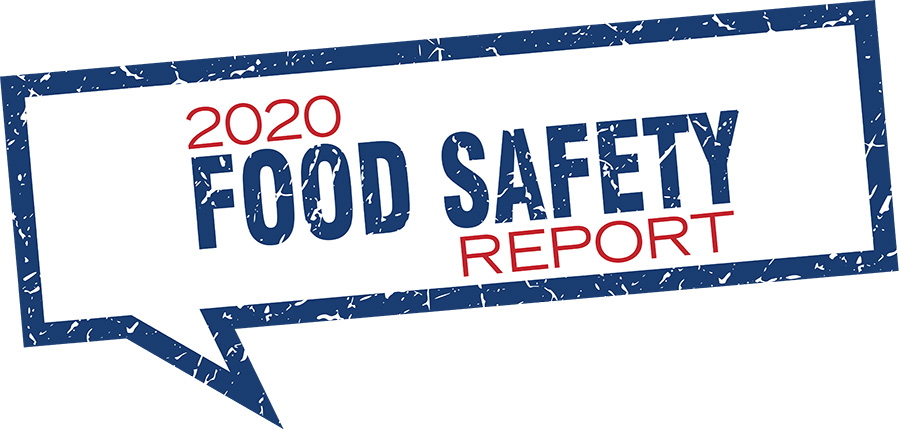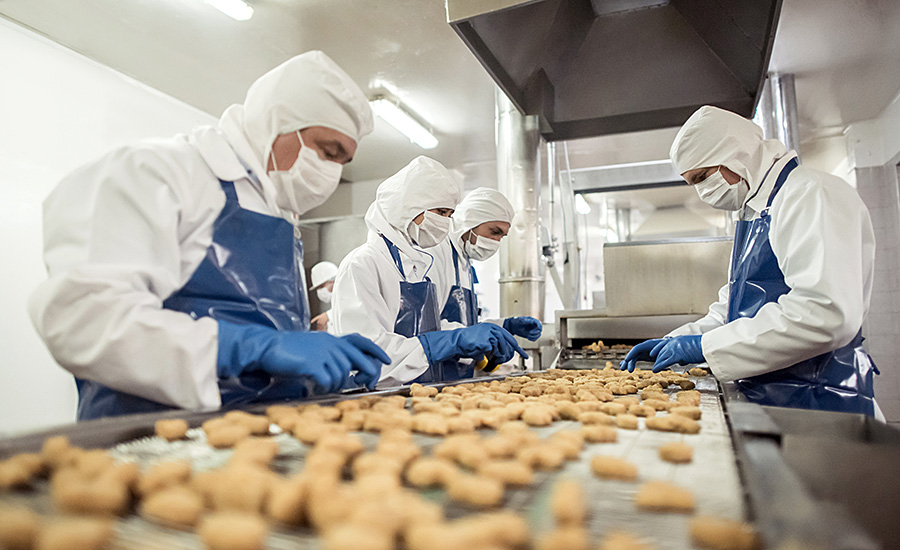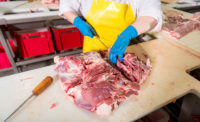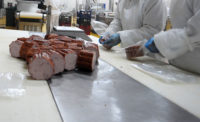Investments in food-safety apparel and training workers to properly wear and handle garments seems a natural course for meat and poultry processors.
The potentially exorbitant cost of outbreaks or product recalls because of tainted products will likely far outweigh the price of purchasing and laundering the necessary garments.
But some operators still fall short in implementing adequate measures, analysts say.

Table of Contents:
“Larger plants that produce ready-to-eat foods are going to treat the environment in a very sanitary manner and will stringently enforce behavior, while smaller plants may not be as forceful,” says Angela Fraser, a professor in the Department of Food, Nutrition and Packaging Sciences at Clemson University, in Clemson, S.C. “It depends on the level of risk they want to take on.”
She says that some smaller plant operators “will say contamination ‘will never happen’ or ‘who cares about that?’ I hear it all the time. Others are like, ‘we don’t want to take that risk so we’re going to impose a strict policy.’ Bigger companies often have more resources to support programs, while smaller processors may not or just choose not to have stringent guidelines if they lack the technical expertise.”
It is essential, however, that all workers wear clean apparel including gloves, smocks and coats when entering the processing floor to reduce the prospect of spreading microbials from their street clothes or skin to food, Fraser says.
“While there have not been outbreaks traced back to dirty clothes, we know dirty clothes harbor microorganisms and can cause the possible transfer of pathogens to food on contact,” she says.
It is most important to safeguard ready-to-eat products, such as deli meats and chicken nuggets, because there typically is no cooking by the end user to kill pathogens, she says.
“We can’t control all risks; we can only minimize risks,” Fraser says. “That is why workers cannot wear uncovered street clothes on the processing floor. Some of the smaller meat and poultry plants don’t understand that.”
The transfer of human detritus such as skin, hair and nails to meat and poultry products also is a safety threat that proper apparel can help contain, says Brian Kellerman, principal food-safety consultant and chief regulatory officer at Kellerman Consulting, a Columbus, Ohio-based food-safety consulting firm.
“Workers with the proper food-safety clothing are unlikely to transmit unsafe biological, chemical or physical hazards to the meat and poultry they are working with,” he says.
A wide array of apparel options
In selecting the appropriate apparel for workers, processors need to consider possible contamination routes and risks while ensuring garments will sufficiently protect employees, says Nicole Keresztes-James, technical scheme manager of food-safety management for NSF International, an Ann Arbor, Mich.-based certification organization that does supply chain assurance and second- and third-party auditing for food manufacturing and processing companies.
She says that to better enhance food safety, operators should also utilize clothing with closures that do not come loose or fall off, garments without pockets, high-quality apparel that will last through multiple cleaning and sanitizing cycles, nets to cover head and facial hair, single-use gloves or those made for easy and frequent cleaning and sanitizing and footwear covers.
“Processors also must continue to educate themselves about the most effective garments available for the industry,” James says.
The optimal apparel for each meat and poultry plant, meanwhile, will differ in conjunction with the particular risks and hazards at each facility, Kellerman says.
“That includes the types of meat and poultry processors are handling and the likelihood of contamination from workers,” he says. “Facilities that have grinding or slicing equipment that requires employee handling will require more extensive protective wear than an automated process where human oversight is observing monitors and readouts.
“Meat and poultry facilities that require the assembly of finished products after cooking, such as frozen burritos, require greater protection through the use of personal protective equipment than uncooked products that are intended to undergo further processing.”
Having concurrent slaughter operations at meat and poultry processing facilities, meanwhile, significantly increases the chance of workers spreading microbials to foods, says Elaine Vanier, technical manager in the NSF International animal wellness program.
“Defining clear boundaries, employee-flow patterns and protective-clothing policies that clearly distinguish areas where the food-safety apparel can and cannot be worn will be necessary,” she says.
Employees handling raw material in one area of a facility should have different apparel protocols than their co-workers who work with cooked meat products in another area, James says.
“Contaminants can make their way from the raw to the cooked area if protocols are not clearly defined and closely monitored,” she says.
James says all clothing worn by workers involved in processing raw meat should be seen as potentially unsanitary and sources of contamination.
“Any contact that occurs between the clothing worn on the raw side and clothing worn on the cooked side could introduce unwanted pathogens to the cooked product,” she says, adding that plant operators should have ongoing surveillance of the processing floor to ensure all workers are wearing the necessary gear.
Keep workers on the right track
Single-use plastic gloves or sanitary utensils are essential for helping to prevent workers from contaminating raw or finished meat and poultry products, Kellerman says, adding that processors should issue uniforms and manage the laundering process to ensure the food safety apparel is always sanitary.
“It is most important to have a sustainable system that provides clean apparel to workers each day and ensures that they wear the items,” he says.
Kellerman says workers can misuse or limit the effectiveness of their food-safety apparel by not changing gloves frequently, behaving in an unsanitary manner (such as wiping one’s nose with a gloved hand) or wearing dirty gear.
“Facilities should provide the necessary apparel and assess its effectiveness at least once a year, which includes checking if workers are wearing the gear properly,” he says.
Operators also should ensure workers remove all apparel when leaving the processing floor and put on fresh garments when returning, Fraser says.
“Microorganisms are endemic in meat and poultry processing areas because of the production of raw materials,” James says. “Worker clothing is guaranteed to become soiled and must be cleaned frequently to minimize cross-contamination risk, including cross-species contamination.”
She says that properly constructed garments that replace or cover personal clothing and do not fray or degrade will help ensure that processors will not expose food products to foreign materials and microorganisms.
Single-use and non-absorbent apparel, including plastic aprons and coats workers can layer over other protective clothing, are ideal for helping to ensure food safety, James says.
But because many organizations that focus on costs and the environment are concerned about reuse, James says traditional cloth uniforms and personal protective equipment are becoming more relevant.
Demonstrating a commitment to safety is crucial
It can be difficult for plant operators to persuade all workers to follow food safety guidelines if the clothing is uncomfortable or employees think the garments cause any sort of disadvantage, James says, noting complaints often range from improper fit to the excessive time it takes to change in and out of the apparel.
Additional causes of non-compliance include inadequate worker training, inconsistent policy enforcement and regulations that are overcomplicated, vague or unclear to workers, she says.
Operators, James says, should solicit feedback from workers about provided apparel because it’s important to understand why employees may be reluctant to wear certain garments. “One size does not fit all,” she says.
“A positive attitude about apparel includes the recognition of equity amongst employees, which means not only giving all the workers apparel, but giving them apparel that fits,” she says. “Sourcing clothing that is both comfortable and appropriate for the environment will go a long way to leveraging compliance amongst the employees.”
Management also should promote the importance of wearing the necessary apparel consistently through education and by example, James says. “They must demonstrate their own commitment to using the necessary apparel,” she says. “A positive attitude around food-safety apparel falls flat as soon as workers see the management ignoring the protocols themselves.”
Kellerman says, however, that even with the proper apparel, employees may generate risk by not wearing the gear properly. He says some processors still allow workers to select clothing without educating them about expectations, which leads to inconsistency and confusion over what is acceptable.
It is crucial for processors to properly train workers on the use of food-safety apparel, but getting those employees to follow procedures still can be challenging, Fraser says. She says many operators may contend with foreign-born workers who have language barriers, cultural differences and varying perceptions about what constitutes sanitary. These operators need to be vigilant in providing ongoing training because of high turnover rates in plants.
More enhancements are on the horizon
Food-safety apparel, meanwhile, continues to evolve with newer designs becoming more effective and comfortable for workers, analysts say. Recent enhancements include the use of lighter-weight materials and moisture-wicking fabric with higher durability, James says.
Still, she says meat and poultry processors are going to demand further improvements from their suppliers.
“Companies that provide cost-effective and high-quality disposable garments that are manufactured in an environmentally sustainable fashion will be in high demand,” James says.
Among the likely improvements to cloth uniforms will be the incorporation of Teflon-like materials to prevent contaminants from absorbing into the fabric while also providing additional strength and endurance, she says.
Operators should look for continuous improvement in the apparel worn in their facilities, James says. This means capitalizing on the expertise of apparel suppliers to gain knowledge, and sharing their needs with those suppliers to inspire solutions.
“All aspects of protective clothing are evolving in their construction as new materials and designs are adopted,” she says. “Innovative fabrics that improve mobility while still providing the needed protection are increasingly available.”
She adds that because sustainability also is an increasing need, “advances in effective cleanability and longevity in garments for continued use will be a demand.” NP





Report Abusive Comment